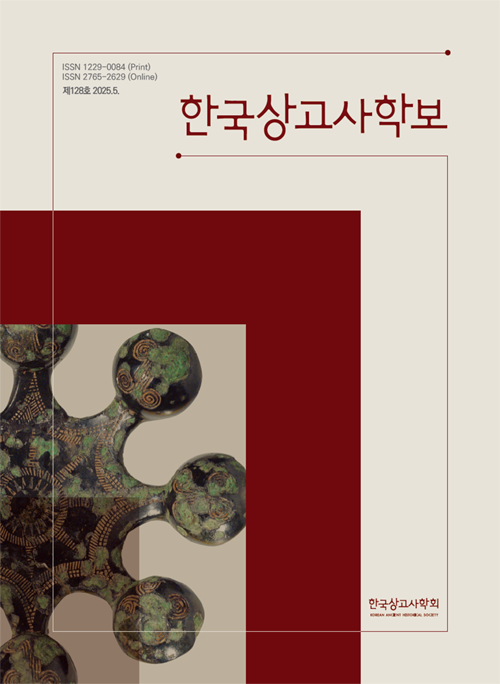- 영문명
- The Nature of the Official Ranks ‘Bogukjanggun輔國將軍 Bongukwang本國王’, and the Identity of ‘Garawang Haji加羅王 荷知’
- 발행기관
- 한국상고사학회
- 저자명
- 신광철(KwangCheol Shin)
- 간행물 정보
- 『한국상고사학보』제128호, 151~184쪽, 전체 34쪽
- 주제분류
- 인문학 > 역사학
- 파일형태
- 발행일자
- 2025.05.31
6,880원
구매일시로부터 72시간 이내에 다운로드 가능합니다.
이 학술논문 정보는 (주)교보문고와 각 발행기관 사이에 저작물 이용 계약이 체결된 것으로, 교보문고를 통해 제공되고 있습니다.

국문 초록
본고는 479년 가라왕이 받은 ‘보국장군 본국왕’이라는 관작의 의미, 가라왕 ‘하지’의 실체에 대 해 再考하고자 작성하였다.
‘보국장군’은 梁代 장군제 개혁이 있기 전까지 대체로 3품 장군직에 해당했으며, ‘본국왕’은 「가락국기」를 근거로 금관국을 일컫는 또 다른 국명에서 기인한 책봉호였음을 확인하였다. 한편, 당대 동방의 모든 군주호는 ‘지절호’나 ‘도독제군사호’ 등이 포함된 형태였는데, 가라왕이 받은 것은 백제 장군이 받은 ‘장군호+왕호’ 형태의 책봉호라는 데에 주목하였다. 기존에는 단순히 고구려·백제·왜왕보다 1품이 낮은 장군호를 받았다는 것에만 주목했지만, 책봉호의 형태를 봤을 때 실제 남제측에서 가라왕을 독립국의 군주보다는 제후국이나 지방 군벌에 준하는 수준으로 인식했을 가능성이 크다고 파악하였다.
또한, ‘하지’는 이름일 가능성을 아예 배제할 수는 없지만, 그보다는 가라 사신이 처음에 접수한 ‘가라(국)왕+질지+한기’라는 공식 명칭이 남제 조정의 외교 관례에 따라 ‘가라(국)왕 하지’로 수정되어 실리게 된 결과로 이해하였다. 5세기 2/4분기까지 세력을 유지하던 금관국은 부산, 합천, 창녕, 고령 등 각지의 신흥 세력이 두각을 드러내자 낮아진 자국의 위상을 되찾고자 남제 遣使라는 타개책을 선택한 것으로 보인다.
한편, 당시 국제 정세를 올바르게 이해하기 위해서는 신라·가야사 연구에 있어 중요한 획기로 언급되는 400년에만 주목할 것이 아니라 4세기 후반~5세기 초반, 고구려와 백제의 대립 관계를 포괄적으로 이해할 필요가 있음을 역설하였다. 그래야만 가라의 남제 견사도 보다 합리적으로 접근할 수 있다고 생각하기 때문이다.
영문 초록
This research reexamines the meaning of the Official Ranks Bogukjanggun Bongukwang and explores the identity of Haji, the so-called Garawang granted to the King of Gara in 479 AD. The title Bogukjanggun corresponded to a third-rank general position before the military reforms of the Liang梁 Dynasty. Meanwhile, Bongukwang appears to have originated from another name for Geumgwan-guk, as recorded in the Records of Garak. Unlike other East Asian rulers of the time, whose titles typically included an Imperial Credential Title or Title of Commander-in-Chief of All Military Affairs, the title bestowed upon the King of Gara followed the structure of Baekje’s military officials, combining a General’s title with a Royal title. However, the structure of this title suggests that Southern Qi likely regarded the King of Gara not as the sovereign of an independent state but rather as a ruler of a vassal state or a regional warlord.
Furthermore, Haji is more likely that the original diplomatic designation—Gara(guk) Wang Jilji Hangi—was modified according to Southern Qi’s diplomatic conventions, resulting in the recorded name Gara(guk) Wang Haji. Until the second quarter of the 5th century, Geumgwan- guk remained in power. However, as emerging powers in Busan, Hapcheon, Changnyeong, and Goryeong gained prominence, Geumgwan-guk may have sought to restore its diminished status by sending an envoy to Southern Qi.
To properly understand the geopolitical context of this period, this study argues that research on Silla and Gaya history should not focus solely on the year 400 AD—often considered a key turning point—but should instead take a broader view encompassing the late 4th to early 5th centuries, particularly the shifting power dynamics between Goguryeo and Baekje. Only then can the dispatch of a diplomatic mission from Gaya to Southern Qi be approached more rationally.
목차
Ⅰ. 머리말
Ⅱ. ‘輔國將軍 本國王’ 官爵의 성격
Ⅲ. ‘加羅王 荷知’의 실체
Ⅳ. 맺음말: 惡化一路
해당간행물 수록 논문
참고문헌
관련논문
최근 이용한 논문
교보eBook 첫 방문을 환영 합니다!

신규가입 혜택 지급이 완료 되었습니다.
바로 사용 가능한 교보e캐시 1,000원 (유효기간 7일)
지금 바로 교보eBook의 다양한 콘텐츠를 이용해 보세요!



